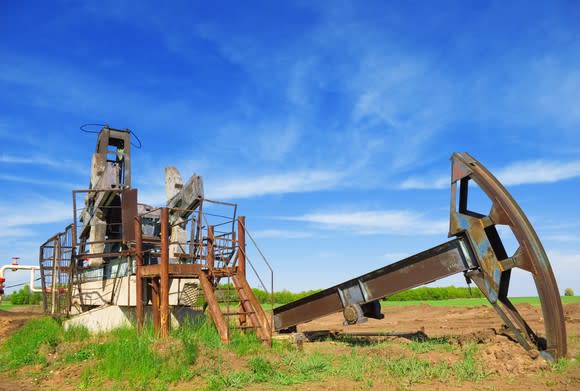3 Stocks I'd Hate to Buy
After several tough years, the oil industry is starting to get back up on its feet. Producers worked hard to reposition their businesses and drive out costs as oil prices crashed, which put many in the position where they can now generate enough cash flow with oil in the upper $50s to grow production.
That said, not all oil companies are back on solid ground, which is a concern since it's possible that oil prices could stumble in 2018. Three that still have a long way to go are California Resources (NYSE: CRC), Pengrowth Energy (NYSE: PGH), and Baytex Energy (NYSE: BTE). That's why I'd hate to buy one of those oil stocks when there are better options available.

Image source: Getty Images.
Nearly buried alive in debt
California Resources is one of the most deeply indebted oil companies in the country. While the California-focused producer has reduced borrowings by $1.6 billion since the second quarter of 2015, its leverage metrics remain near the bottom of the barrel since it still has $5.1 billion in debt outstanding. For example, at the end of the third quarter, it had a debt-to-capitalization ratio of 112% while most oil companies like to keep that number below 30%. Meanwhile, its debt-to-EBITDA ratio was an unsightly 7.3 times versus the less than 3.0 times most oil companies prefer, with many now targeting to get that number below 2.0 times.
California Resources' debt is stifling its ability to operate. The company isn't currently generating enough cash flow to maintain its production level, which is why output fell 7% over the past year and slipped another 1% in the last quarter. Furthermore, while it believes production could rise by a 5% compound annual rate through 2021, it needs oil to average $60 a barrel so it would generate the cash to fund that plan. While it's possible crude could hit that level, several rivals can grow at an even faster rate at $50 oil, which makes them much better investment options.
What just went down is about to come back up
Canadian oil and gas producer Pengrowth Energy sold nearly 1 billion Canadian dollars' ($780 million) worth of assets this year. That gave it the money to pay off its near-term debt maturities, which saved it from a liquidity crisis. So the company signed agreements with creditors to loosen the terms on its remaining borrowings, so it has the financial flexibility to invest in growth projects.
In fact, the company hopes to sanction phase two of its Lindbergh heavy oil facility, which could increase production from about 14,500 barrels per day up to 40,000 barrels. That said, there are two concerns with this plan. First, it would need to tack on more debt in the near term to finance that expansion, which is a step in the wrong direction. In addition, the investment to expand Lindberg would only earn a 20% return at $55 oil, which is well below what rivals can earn on some of their projects at that price point. That combination of a weakening balance sheet and a lower returning core asset makes Pengrowth an oil stock I'd rather not own since there are better ones available.

Image source: Getty Images.
It's doing OK, but it's still well behind rivals
On the one hand, Canadian oil producer Baytex Energy seems to be back on solid ground. It has a much stronger asset base, with its wells earning returns between 60% to 90% at $55 oil. Because of that, the company recently announced that production should increase 6% by the end of next year versus where it will be at the end of 2017. It can also achieve that plan within cash flow as long as oil average $55 a barrel.
That said, Baytex Energy's growth rate is well below that of other oil companies since many can increase production at a double-digit rate next year at that oil price. One of the reasons Baytex can't grow as fast is that it still has more than CA$1.7 billion ($1.3 billion) of debt outstanding, which is a significant level given its size. For perspective, debt makes up 67% of its total enterprise value, while many oil companies have that number below 10%. Because of that, a much higher portion of Baytex's cash flow goes toward interest expenses, which gives it less money to grow production. If oil fell to $50 a barrel, Baytex would barely generate enough cash to maintain output while some rivals could still expand theirs by more than 10%.
Why consider OK when you could have great
While California Resources, Pengrowth Energy, and Baytex Energy have improved their financial situation over the past few years, they're still well behind rivals. Consequently, they would struggle if crude prices dipped back toward $50 a barrel. That's why I'd hate to buy one of those oil stocks when several oil companies can thrive at $50 a barrel, making them the better ones to consider buying.
More From The Motley Fool
6 Years Later, 6 Charts That Show How Far Apple, Inc. Has Come Since Steve Jobs' Passing
Why You're Smart to Buy Shopify Inc. (US) -- Despite Citron's Report
Matthew DiLallo has no position in any of the stocks mentioned. The Motley Fool has no position in any of the stocks mentioned. The Motley Fool has a disclosure policy.

 Yahoo Finance
Yahoo Finance 